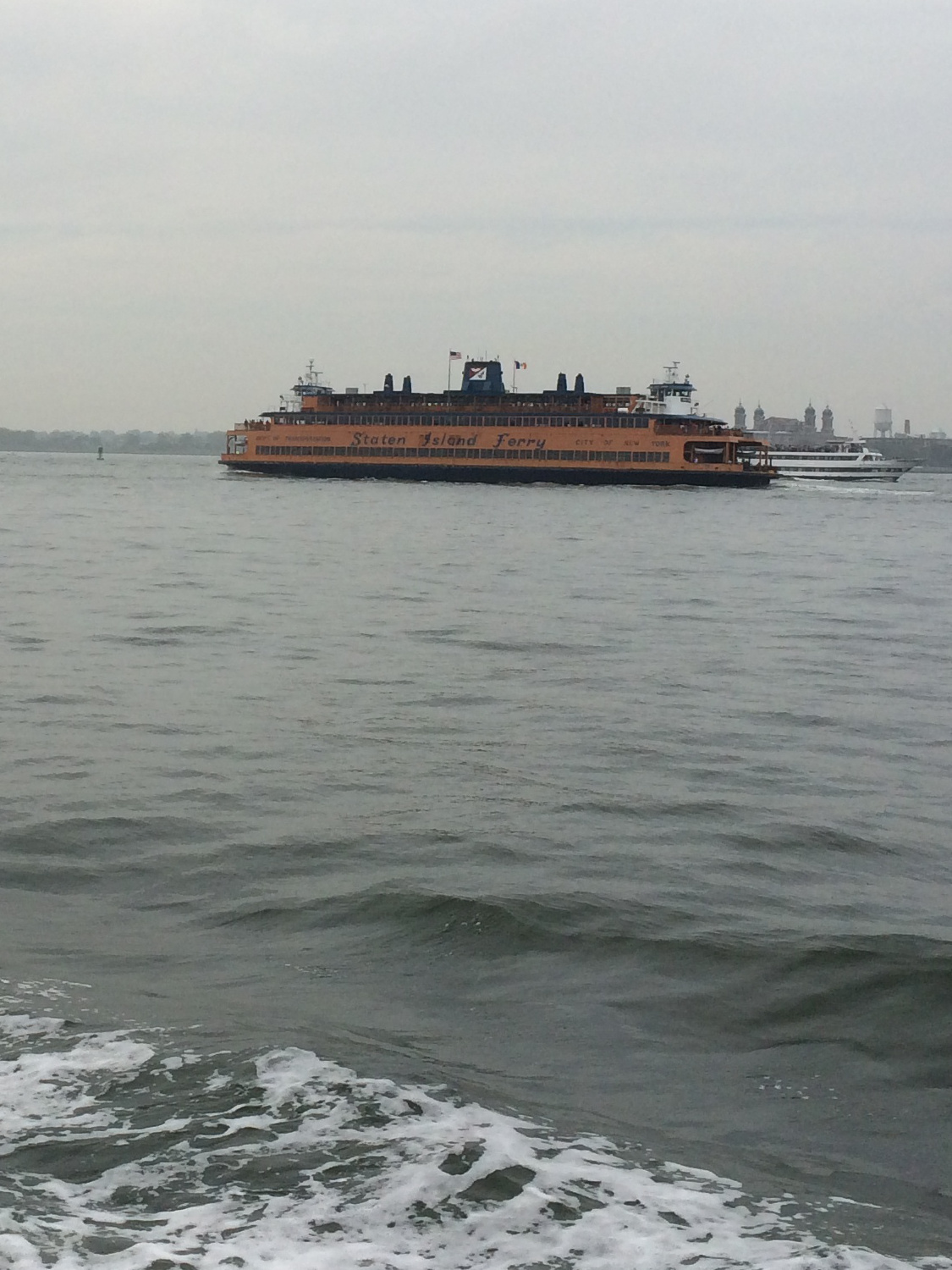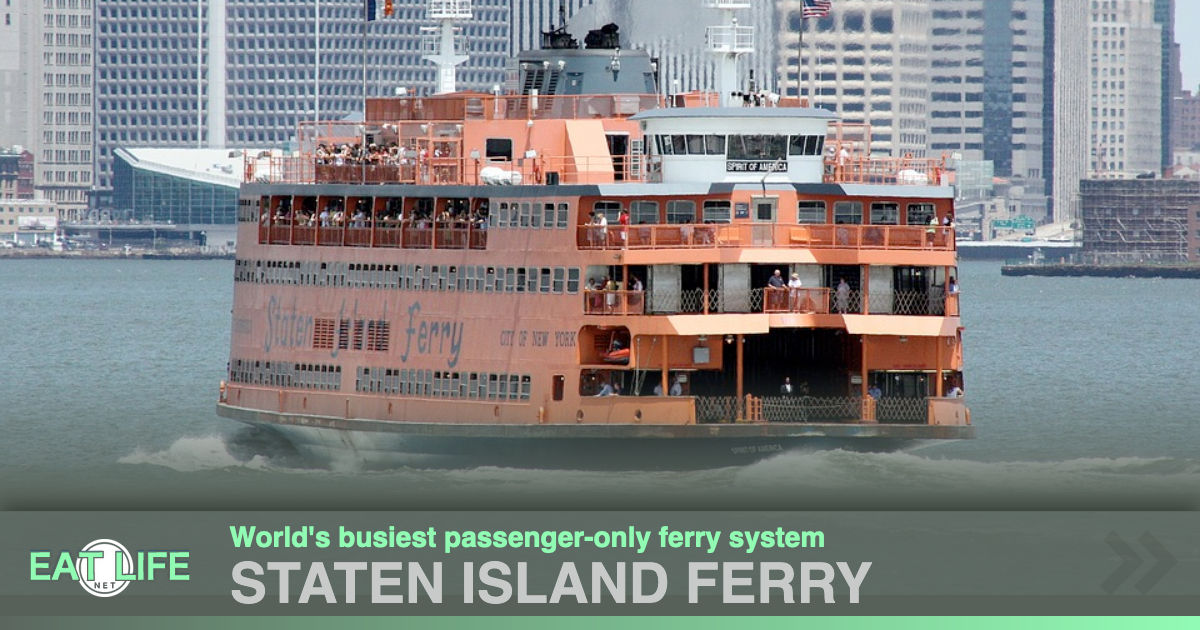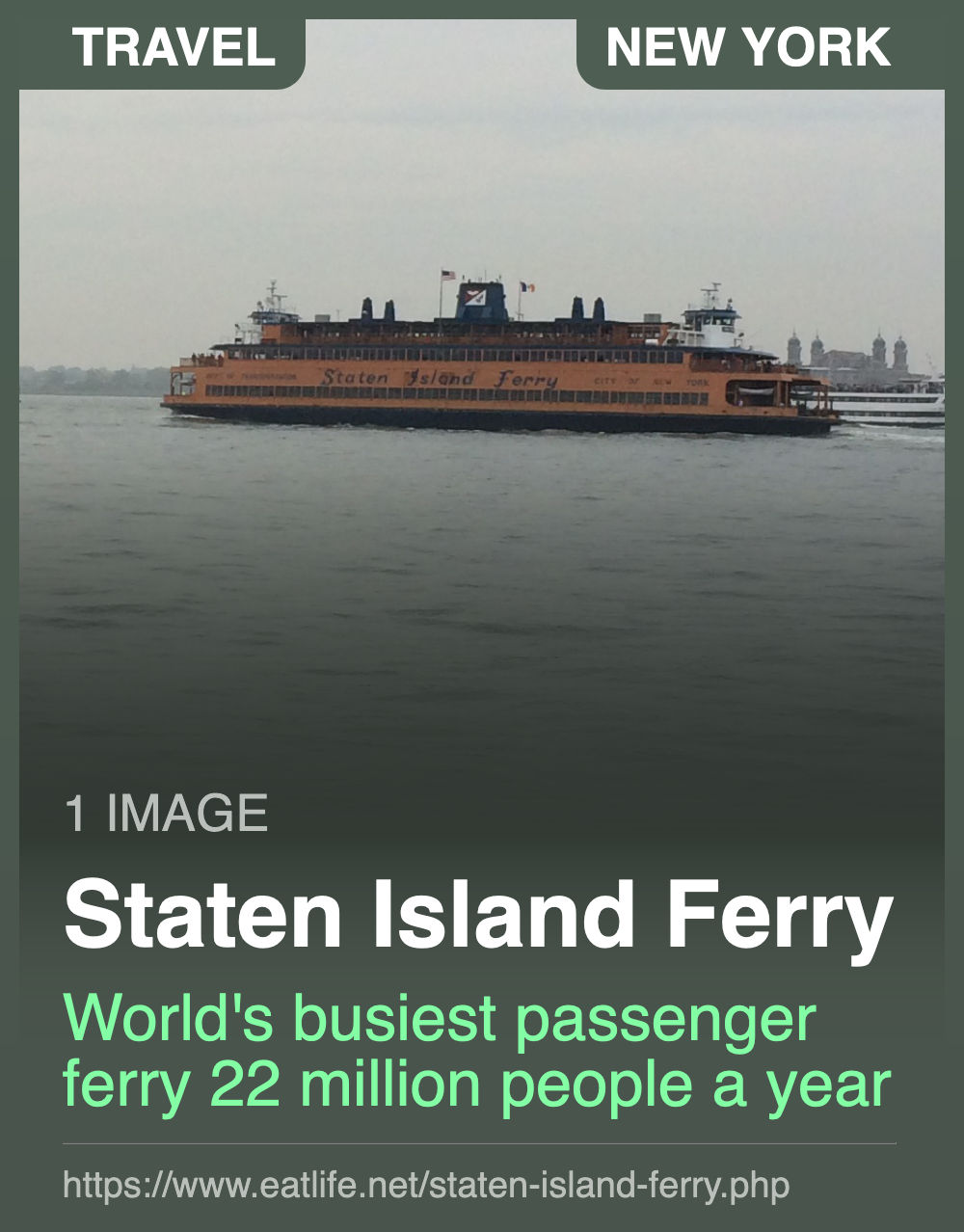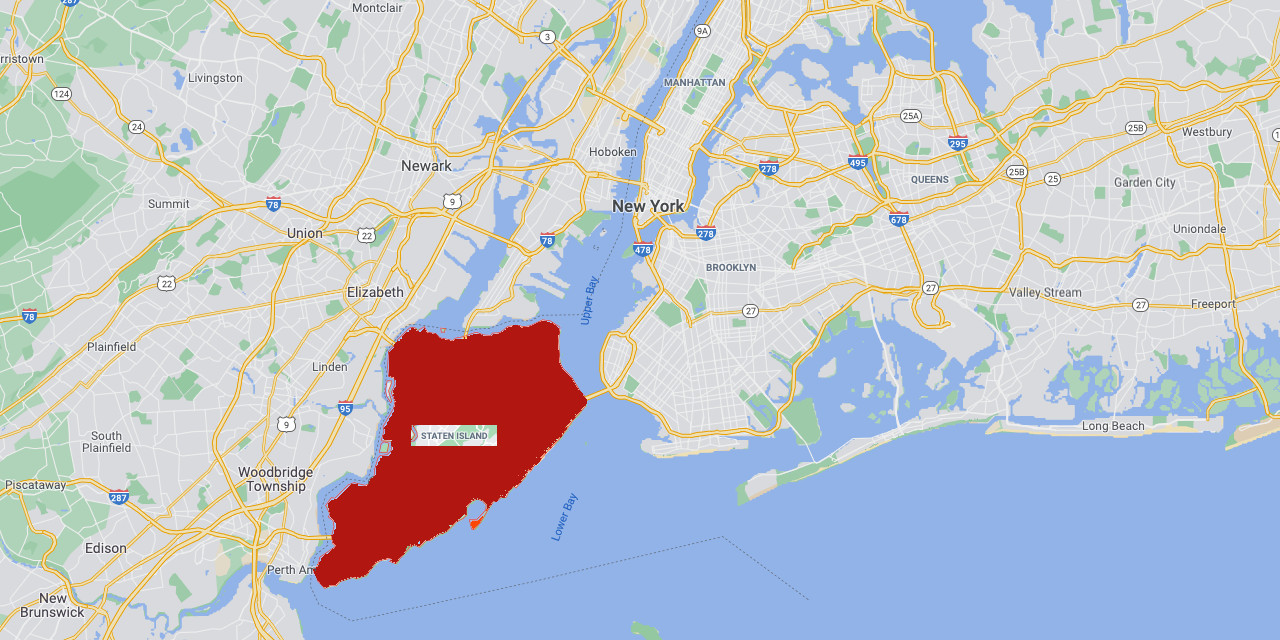
https://www.google.com/maps/place/Staten+Island,+NY
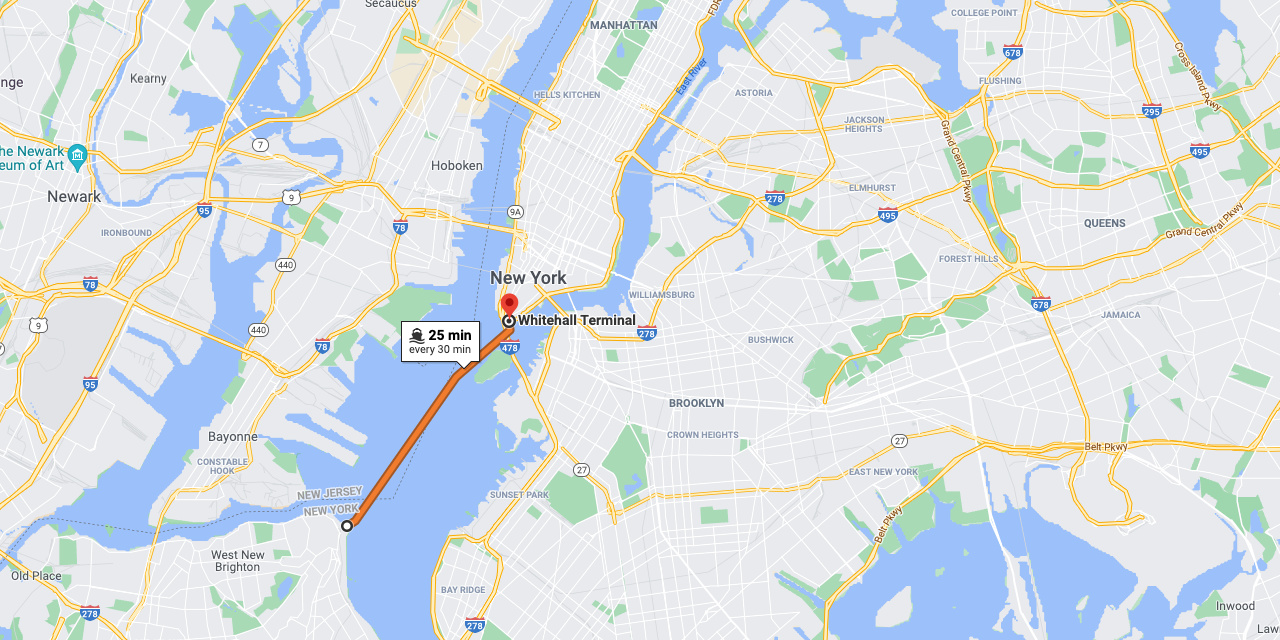
The ferry ride each way is approximately 25 minutes. You must get off at the Staten Island side. Depending on the size of the crowd, it is possible to join the queue to get immediately back on the ferry and spend only an hour for the ride back and forth.
https://www.google.com/maps/dir/''/Whitehall+Terminal,+4+Whitehall+St,+New+York,+NY+10004
The Staten Island Ferry:
One of the last remaining vestiges of an entire ferry system in New York City that transported people between Manhattan and its future boroughs long before any bridges were built.In Staten Island, the northern shores were spiked in piers, competing ferry operators braved the busy waters of New York harbor.
Today the Staten Island Ferry provides 22 million people a year (70,000 passengers a day not including weekend days) with ferry service between Saint George on Staten Island and Whitehall Street in lower Manhattan.
The ferry is the only non-vehicular mode of transportation between Staten Island and Manhattan.
NYC DOT operates and maintains the nine-vessel fleet as well as the Saint George Ferry Terminal on Staten Island, Whitehall Ferry Terminal in Manhattan, the City Island and Hart Island Facilities, The Battery Maritime Building and all floating dock building equipment.
The Staten Island Ferry is a free service provided by the City of New York. Be aware of scammers trying to sell tickets.The Staten Island Ferry is run by the City of New York for one pragmatic reason: To transport Staten Islanders to and from Manhattan. Yet, the 5-mile, 25-minute ride also provides a majestic view of New York Harbor and a no-hassle, even romantic, boat ride, for free!
One guide book calls it "One of the world's greatest (and shortest) water voyages." From the deck of the ferry you will have a perfect view of The Statue of Liberty and Ellis Island. You'll see the skyscrapers and bridges of Lower Manhattan receding as you pull away and coming into focus again as you return.
A typical weekday schedule involves the use of four boats to transport approximately 70,000 passengers daily (117 daily trips).
During the day, between rush hours, boats are regularly fueled, and maintenance work is performed. Terminals are cleaned around the clock and routine terminal maintenance is performed on the day shift.
On weekends, three boats are used (96 trips each Saturday and 96 trips each Sunday). About 40,404 trips are made annually.
Ferry service between Staten Island and the city of New York was conducted by private individuals with "per augers", shallow-draft, twin-mast sailboats used for local traffic in New York harbor.
19th century:
Vice President (and former New York governor) Daniel D. Tompkins secured a charter for the Richmond Turnpike Company, as part of his efforts to develop the village of Tompkinsville.
Although this was intended to build a highway across Staten Island, the company also received the right to run a ferry to New York.
The Richmond Turnpike Company is the direct ancestor of the current municipal ferry, the Staten Island Ferry
1817:
The Richmond Turnpike Company began to run the first mechanically powered ferry between New York and Staten Island, the steam-powered Nautilus.
It was commanded by Captain John De Forest, the brother-in-law of a young man named Cornelius Vanderbilt.
1838 Cornelius Vanderbilt:
Vanderbilt, who had grown wealthy in the steamboat business in New York waters, bought control of the company.
Except for a brief period in the 1850s, he would remain the dominant figure in the ferry service until the Civil War, when he sold it to the Staten Island Railway, led by his brother Jacob Vanderbilt.
1850s:
Staten Island developed rapidly, and the ferry accordingly grew in importance.
But the poor condition of the boats became a source of chronic complaint, as did the limited schedule.
The opening of the Staten Island Railway in 1860 increased traffic further and newer boats were acquired, named after the towns of Richmond County which covered the whole of Staten Island.
1871 The Westfield:
One of these ferries, the Westfield, came to grief when its boiler exploded while sitting in its slip at South Ferry (Manhattan) at about 1:30 in the afternoon of July 30, 1871 The New York Times described the disaster.
Within days of the disaster, some 85 were identified as dead and hundreds injured, and several more were added to the death toll in the weeks following.
Jacob Vanderbilt, president of the Staten Island Railway, was arrested for murder, though he escaped conviction.
The engineer of Westfield was a black man, which aroused openly racist commentary in New York's newspapers, though Vanderbilt stoutly defended his employee.
Victims were never compensated for damages.
1884 SIRT:
The competing ferry services that were all finally controlled by Vanderbilt were sold to the Baltimore and Ohio Railroad and operated by the Staten Island Rapid Transit Railroad (SIRT, predecessor to Staten Island Railway) in 1884.
1901 The Northfield:
The SIRT ferry Northfield was leaving the ferry port at Whitehall when it was struck by a Jersey Central Ferry and sank immediately.
There were two full deck crews aboard Northfield and their swift actions ensured that out of 995 passengers aboard, only five ended up missing, presumed drowned.
This accident, though minor in comparison to the Westfield Disaster, was seized upon by the City of New York as a justification to seize control of the SIRT ferries, Staten Island now being officially part of New York City, as the Borough of Richmond.
1905:
Ferry service was assumed by the city's Department of Docks and Ferries in 1905.
Five new ferries, one named for each of the new boroughs, were commissioned.
The First ferry to make the now famous trip across New York harbor as a Staten Island Ferry was named the Manhattan.
- In the 1700s, ferry service was provided by private individuals with small twin mast sailboats called per augers.
- In 1817 the cost to cross the harbor was 25 cents and half price for children. This was the cost to ride the Nautilus, the first steam ferry to make the famous trip. The Nautilus was commanded by Captain John De Forest
- Three of the ferries that were built to make the trip across the harbor were bought by the U.S. Navy to fight in the civil war. The Southfield I, Westfield I, and the Clifton I. None of these ferries ever returned to New York.
- On July 30, 1871 at about 1:30 pm the ferry boat Westfield II experienced a catastrophic boiler explosion while in the slip at Whitehall. Several days after the disaster it was revealed that at least 85 people had lost their lives. Several more were added to the death toll weeks later.
- The 5 cents fare was established in 1897. On October 10, 1972 the fare was raised to 10 cents. In 1975 the fare was increased to 25 cents. On August 1, 1990 the fare went up to 50 cents. Finally, on July 4, 1997 the fare for foot passengers on the ferry was eliminated.
- June 14th, 1901 the ferryboat Northfield was leaving Whitehall when it was struck by a Jersey Central Ferry the Mauch Chaunk and sank immediately. Fortunately, there were two full deck crews aboard the Northfield and their swift actions saved many. Out of 995 passengers aboard the Northfield only 5 ended up missing. This accident was one of the major reasons that private operations of the ferries were ended, and the City of New York took control.
- Soon after Staten Island joined New York City in 1898, ferry service between St. George and Whitehall was transferred to the city Department of Docks and Ferries on October 25th, 1905 and five new ferries -- one named for each of the five boroughs -- were commissioned.
- In 1926 the city's original white color scheme was eliminated in favor of a reddish-maroon. This was changed to municipal orange later so that they could be seen in heavy fog and snow.
- On February 8, 1958 The Dongan Hills was hit by the Norwegian tanker Tynefield. 15 passengers were injured.
- In 1960, a bomb was set off on the Knickerbocker. There were no injuries.
- The Pvt. Joseph Merrill and Cornelius G. Kolff ferries were converted to prison dormitories for Riker's Island.
- In 1978, the American Legion crashed into the concrete seawall near the Statue of Liberty ferry port during a dense fog. 173 were injured.
- Steam was used on the Staten Island ferries up until the 1980's
- On May 16, 1981, the American Legion was rammed in the fog by a Norwegian freighter.
- July 7th, 1986 a mentally disturbed person (Juan Gonzalez) with a machete attacked passengers on a ferry. Two people were killed, and nine others were wounded.
- On April 12th, 1995 The Ferry boat Barberi plowed into 4 slip in St. George due to a mechanical malfunction leaving 4 slip out of service and injuring a handful of passengers. The doors on the saloon deck were crushed by the aprons.
- September 19th, 1997 a car drove off the Staten Island Ferry and plunged into the water as the boat was approaching the slip. The force of the impact on the car hitting the water blow out the rear windshield of the car. This rush of water also carried the driver of the car out the back windshield. One deck hand was knocked into the water by the scissor gates at the front of the boat as the car pushed them aside.
- After the 9/11 attack on the World Trade Center the Staten Island Ferry transported tens of thousands of people out of lower Manhattan to safety on Staten Island. The captains docked the ferries under zero visibility as the smoke and debris from the collapses filled the sky. The following days passengers were not allowed on the ferries. The fleet was being used to transport emergency personnel and equipment. Since that day the Staten Island Ferry no longer carries cars.
- October 15, 2003 at about 15:30 the ferry boat Andrew J. Barberi slammed into a maintenance pier at the Staten Island Maintenance Facility on Staten Island. 10 people died that day and an 11th person died two months later due to injuries from the accident.
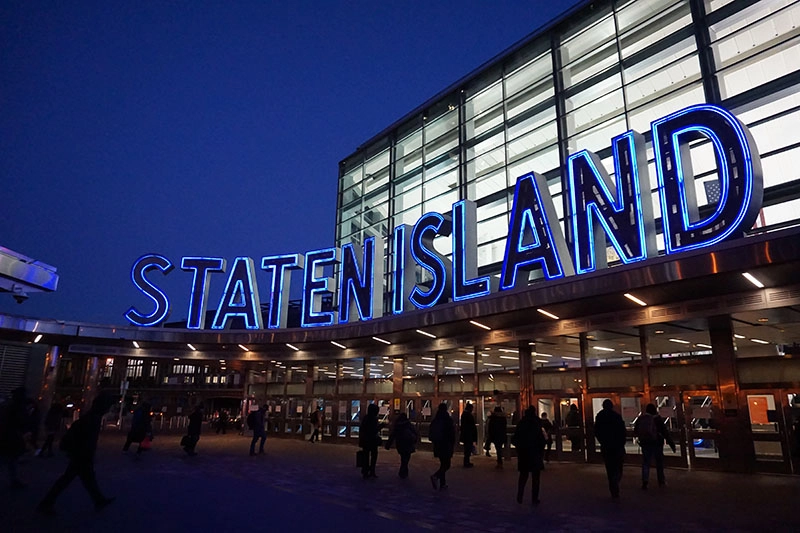
From Manhattan travel to South Ferry/Whitehall Street and exit the subway station, walk a few minutes and then enter the ferry terminal.
You'll probably need to wait patiently among anxious commuters and bright-eyed tourists until the stately orange vessel appears. Then, along with hundreds of other passengers, you'll board and scramble for a good seat with a view. Yes, that view is going to be spectacular! (When the weather is pleasant, you might aim for a standing-only spot on the deck)
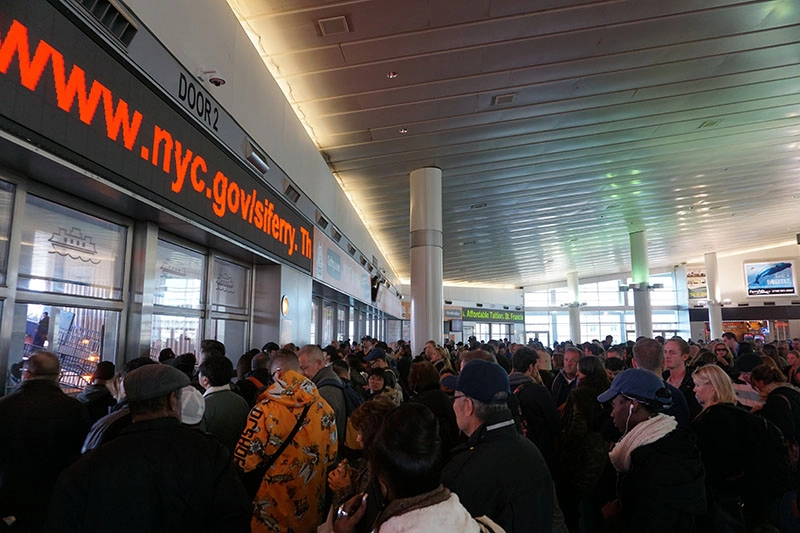
https://www.tracysnewyorklife.com/whats-life-like-in-st-george-staten-island

The Staten Island ferry runs 24 hours a day and 7 days a week. You can ride it day and night. Night rides are quite beautiful.
The schedule is easy to understand. The ferries run every 30 minutes, on the hour and on the half-hour (so, 12:00, 12:30, 1:00, 1:30).
There is one exception. During weekday rush hours, the ferries run every 15 minutes.
Rush hours are 6:00 am until 9:30 am in the morning and 3:30 pm until 8:00 pm in the late afternoon and evening.
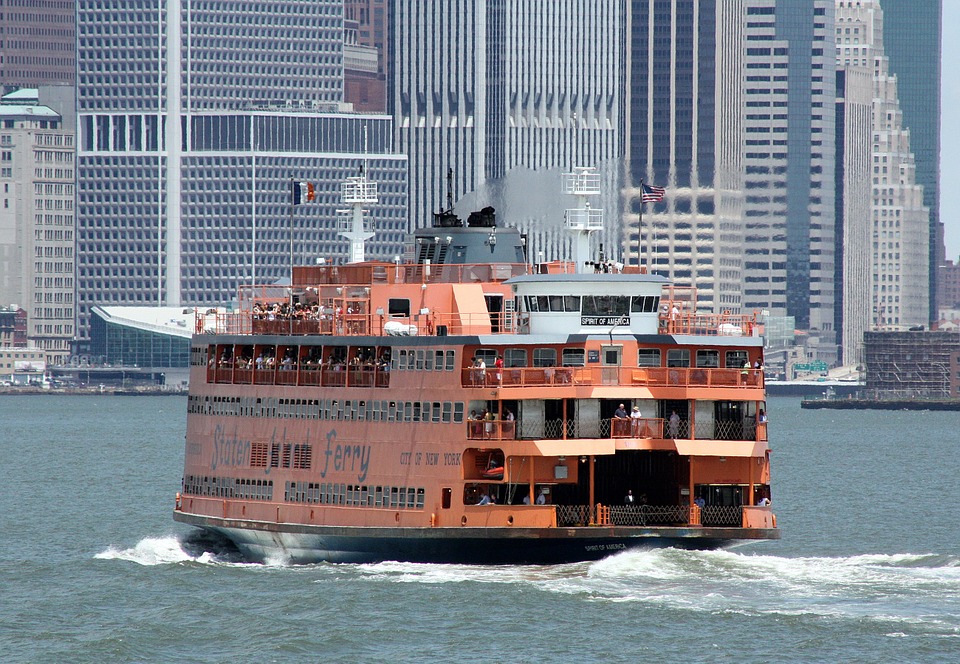
For most of its history, the Staten Island Ferry cost a fare. In 1990, this was around $0.50 for a one-way trip. This caused some understandable irritation for Staten Island residents, because they had to pay a fare for the ferry and additional subway or bus fare once they arrived in Manhattan. Tensions grew, and Staten Island actually threatened to secede from New York City. That motion unexpectedly made it all the way to Albany, the state's capital, where legislators almost voted it into law.
Luckily, Mayor Rudolph Giuliani stepped in. As part of an MTA transfer scheme in 1997 ("one-city, one-fare"), Giuliani declared that Staten Island transit riders could pay the single fare on a Staten Island bus or train and get a free transfer to a Manhattan bus or train by taking the ferry at no additional cost, and vice versa. In response, any other competing ferries went out of business, and the Staten Island Ferry cemented its role as king of the hill.
Officials have proposed numerous alternatives — bridges, express ferries, a tunnel from Staten Island to Manhattan that was never built. Despite this, the Staten Island Ferry still emerges as the quickest, most reliable, and probably most scenic way to commute between the two boroughs. From transporting cargo during the War of 1812 to rescuing people during one of our nation's most intense disasters, the ferry has stood proud for more than a century. New York truly wouldn't be New York without it.
The Staten Island Ferry is the single busiest ferry route in the United States of America, and the busiest passenger-only ferry system in the entire world. The Staten Island Ferry boasts a 24-hour schedule. That's right: it never stops. It takes trips every half hour on the half hour, and every 20 minutes during rush hour. Each ferry has a capacity of around 5,000 people, and daily ridership frequently tops 70,000 passengers a day.
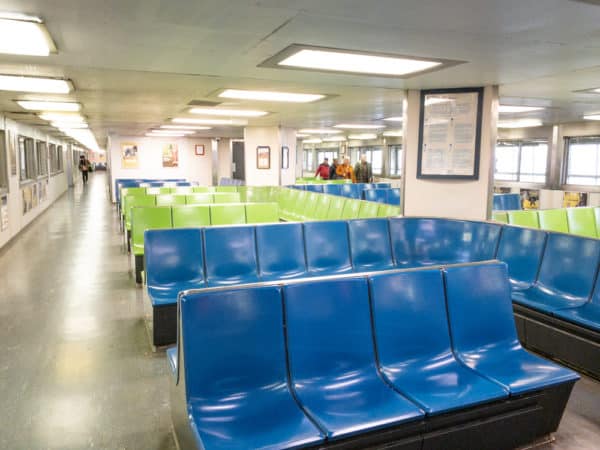
The interior of the ferry boats varies depending on which boat you are on, but they are all rather utilitarian in their seating options. For amenities, the vessels typically have a small snack bar serving a selection of food and drinks if you want to get a snack while on the water.
https://uncoveringnewyork.com/staten-island-ferry
Are there food concessions aboard the boats, and do they serve liquor?
Yes, there is a food concession aboard every boat. Beer is sold, but not hard liquor. The food concessions are open when ever a boat is running (24/7).
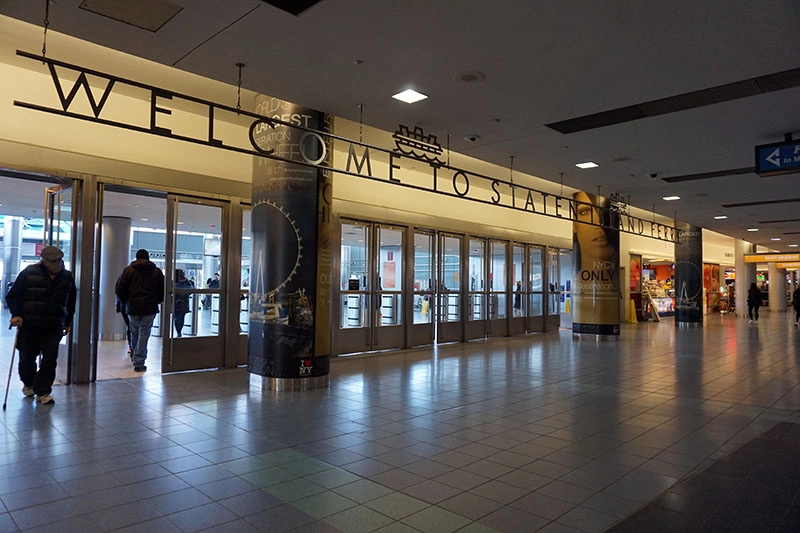
The esplanade is the first thing you'll notice when you disembark the ferry, and you'll be drawn to the modern, sculpture-like twin structures. The 9-11 Memorial or "Postcards" honors the Staten Island residents killed in the 1993 and 2001 terrorist attacks. The memorial holds 270 plaques engraved with the names of Staten Island locals who lost their lives on September 11, 2001. It's a beautiful tribute that frames where the towers once stood, and One World Trade is across the harbor.
https://www.tracysnewyorklife.com/whats-life-like-in-st-george-staten-island
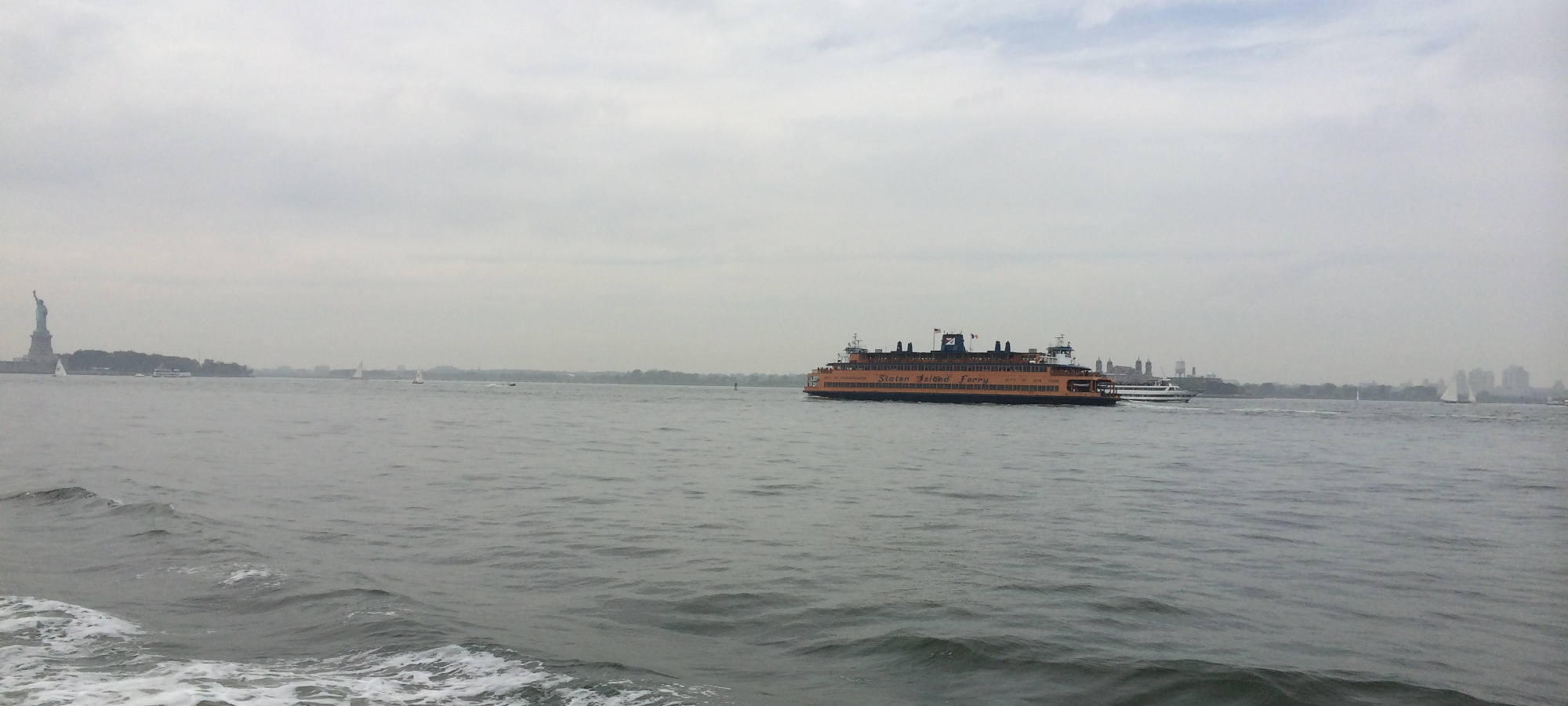
The Staten Island Ferry is a passenger ferry route operated by the New York City Department of Transportation.The Staten Island Ferry:
- The ferry's single route runs 5.2 miles through New York Harbor between the New York City boroughs of Manhattan and Staten Island.
- Ferry boats making the trip in about 25 minutes.
- The ferry operates 24 hours a day, 7 days a week, with boats leaving every 15 to 20 minutes during peak hours and every 30 minutes at other times.
- It is the only direct mass-transit connection between the two boroughs.
- Historically, the Staten Island Ferry has charged a relatively low fare compared to other modes of transit in the area; and since 1997 the route has been fare-free.
- The Staten Island Ferry is one of several ferry systems in the New York City area and is operated separately from systems such as NYC Ferry and NY Waterway.
The Staten Island Ferry route terminates at Whitehall Terminal, on Whitehall Street in Lower Manhattan, and at St. George Terminal, in St. George, Staten Island.
Using MetroCard fare cards, passengers from Manhattan can exit a subway or bus on Whitehall Street, take the ferry for free, and have a free second transfer to a train or bus at St. George. Conversely, passengers from Staten Island can freely transfer to a subway or bus in Manhattan after riding the ferry.
- At Whitehall, connections are available to the New York City Subway and several local New York City Bus routes.
- At Saint George, there are transfers to the Staten Island Railway and to the Saint George Bus Terminal's many bus routes.
The Staten Island Ferry originated in 1817, when the Richmond Turnpike Company started a steamboat service from Manhattan to Staten Island. Cornelius Vanderbilt bought the Richmond Turnpike Company in 1838, and it was merged with two competitors in 1853. The combined company was in turn sold to the Staten Island Railroad Company in 1864. The Staten Island Ferry was then sold to the Baltimore and Ohio Railroad in 1884, and the City of New York assumed control of the ferry in 1905.
In the early 20th century, the city and private companies also operated ferry routes from Staten Island to Brooklyn. Owing to the growth of vehicular travel, all of the routes from Staten Island to Brooklyn were decommissioned by the mid-1960s; but popular demand preserved the route to Manhattan. By 1967, the Staten Island-to-Manhattan ferry was the only commuter ferry within the entire city.
A fast ferry route from Staten Island to Midtown Manhattan ran briefly from 1997 to 1998; proposals to revive the route resurfaced in the 2010s.
4 Whitehall Street
New York, NY 10004
https://www1.nyc.gov/html/dot/html/ferrybus/staten-island-ferry.shtml
1 Bay Street
Staten Island, NY 10301
